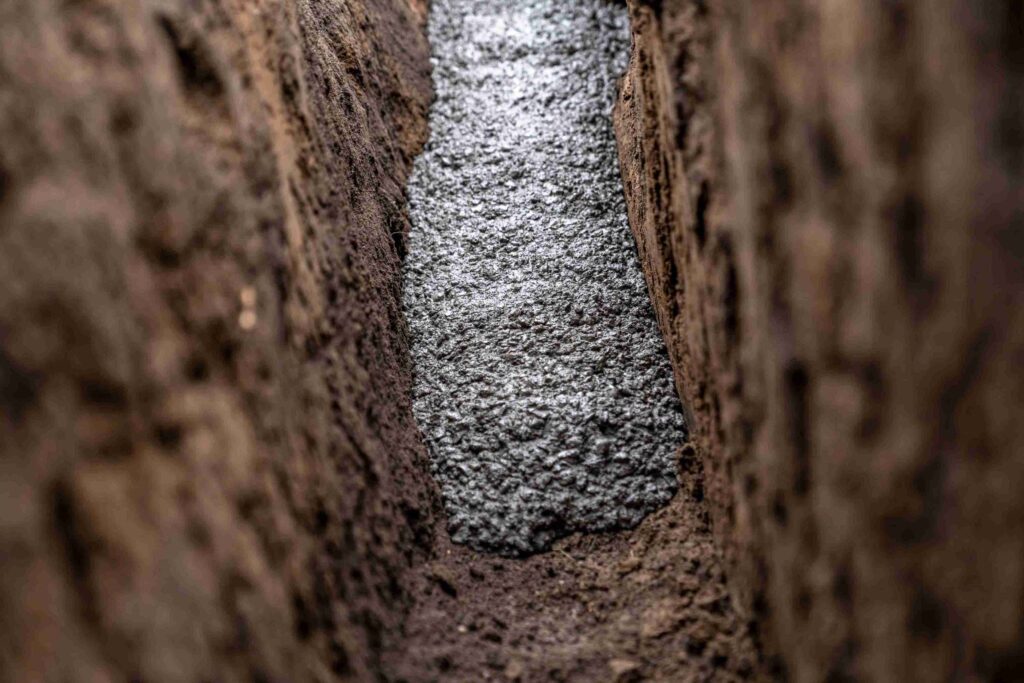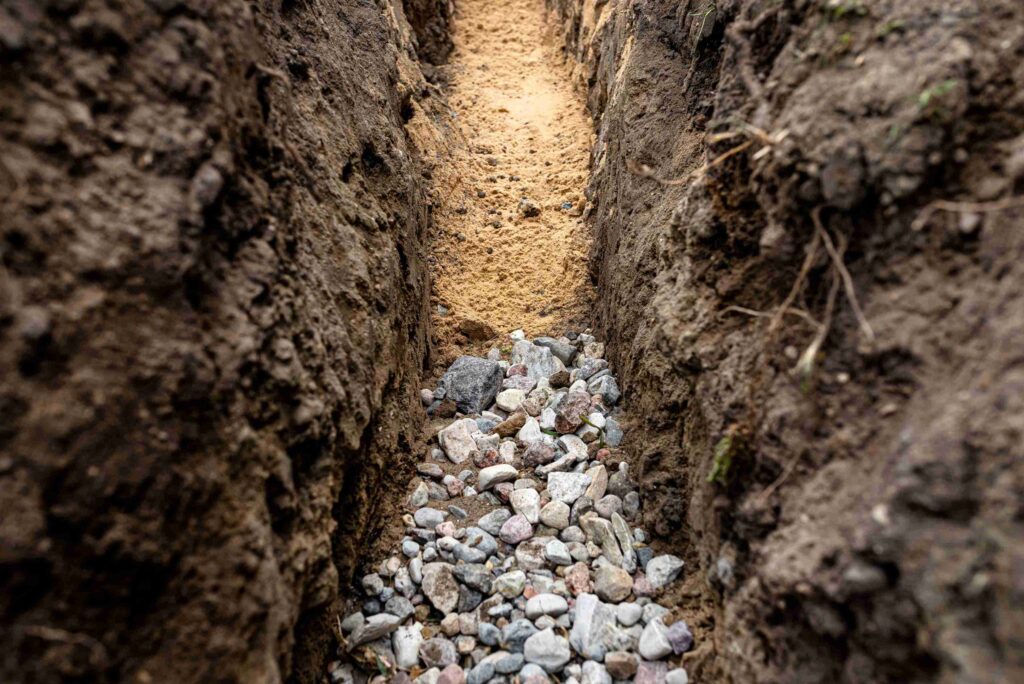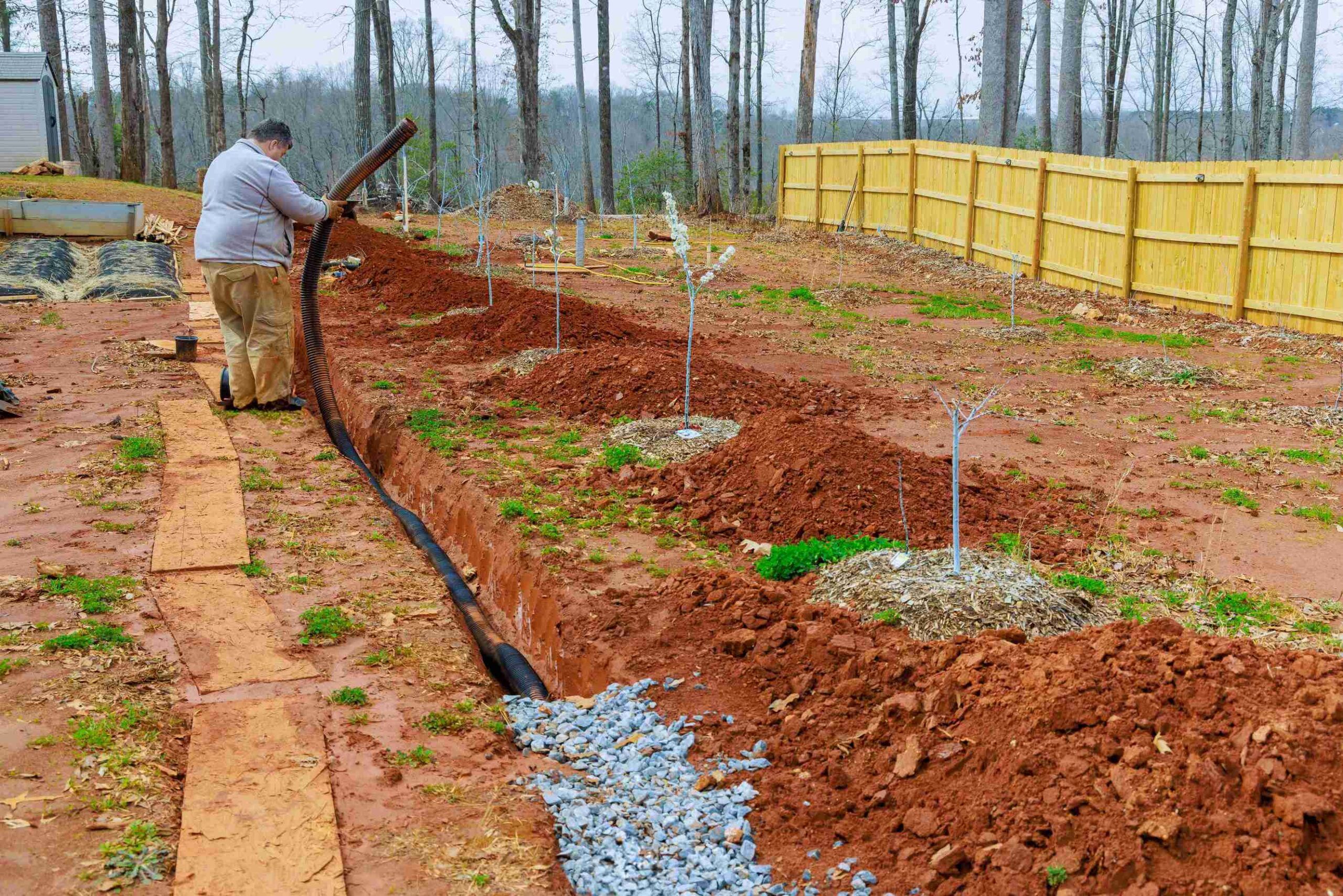How Much Does A French Drain Cost In Florida?
If you live in Florida, you know how fast a heavy rain can turn your yard into a swamp.
Water pooling around your home can wreck your lawn, erode your foundation, and even seep into your house. That’s why French drains are so popular here.
They’re one of the most effective ways to move water away from problem areas and protect your property long-term.
But once you start thinking about actually putting one in your home, the next obvious question is: how much is this going to cost?
In this post, we’ll break down how much does a french drain cost and the factors that affect the final price. We’ll also give you a rundown of our french drain installation prices.
Our French Drain Installation Prices
We charge up to $55 per linear foot for French drain installation.
That price includes a full drainage system – not just a basic pipe.
We install solid pipe and French drain in the same trench, haul away all the excess dirt, replace it with drainage rock, and wrap the system with high-quality drainage fabric that’s built to last.
It’s a full setup designed to move water efficiently and hold up over time. No shortcuts, just solid drainage done right.
Check Out Our French Drain Installation Services In Central Florida
How Much Does A French Drain Cost?
A french drain costs between $20 to $75 per linear foot in Florida.
So for a 50-foot system, you’re looking at roughly $1,000 to $3,750, depending on the setup.
Indoor drains (like the kind inside a basement or crawlspace) usually cost more – sometimes up to $100 per foot. But for most Florida homeowners, especially those dealing with yard drainage or foundation runoff, you’re usually looking at exterior drains, which are cheaper and easier to install.

If you’re the DIY type and ready to rent a trencher, you might bring that cost down to around $10 to $20 per foot, depending on the materials you choose.
Factors That Affect The Cost Of A French Drain
A lot goes into figuring out the final cost of a french drain. Here are some of the main factors that can affect how much you’ll end up paying:
#1 Size And Length Of The Drain
The size of your French drain is one of the most obvious factors.
The bigger the area that needs draining, the longer the trench will be, and the more material you’ll need.
A small, basic French drain for a small yard will cost less. But if you have a large lawn or a bigger drainage problem, it could require a much longer drain, which drives up the cost.
When you think about it, it’s pretty simple: the more surface area there is to cover, the more material, labor, and time it takes.
Also Read: How Much Does Basement Waterproofing Cost?
#2 Depth Of The Trench
Another factor that affects french drain costs is how deep the trench needs to be.
The typical French drain is around 18 to 24 inches deep, but in certain areas, it could be much deeper. If you have to dig deeper to reach the right drainage level or if your property has a slope or uneven ground, it’s going to take more effort.
And naturally, more digging means higher labor costs.
It’s also harder work, so contractors tend to charge a bit more for that.
If you’re trying to stop water from reaching your foundation or basement, you may need a much deeper trench along with the higher costs that come with it.
#3 Type Of French Drain
There are a few different types of french drains and the type you choose will also affect the cost.
Basic yard drains are the most affordable and are usually installed just below the surface. These are ideal for handling standing water in lawns or redirecting runoff.
More complex systems (like those inside basements or around foundations) require different materials, waterproofing membranes, sump pumps, or deeper excavation.
These extra features can significantly increase the price.
The type you need will depend on where the water is and how it’s affecting your property.

Also Read: French Drains In Cold Climates
#4 Materials Used
What materials go into your French drain will also affect the cost of a French drain.
The most common materials are:
- Perforated PVC or corrugated pipe
- Drainage fabric (to keep out dirt and roots)
- Gravel or rock
- Catch basins or clean-outs (optional but helpful)
The quality of the materials can vary, and if you choose higher-end options, like better drainage pipe or premium gravel, it will bump up the price.
But using lower-cost materials may not always offer the best long-term results, so it’s important to find a balance.
#5 Labor Costs
Labor is one of the largest parts of the total cost.
Installing a French drain is no easy task. You need to dig trenches, lay pipe, and then fill it all in with gravel and landscape fabric.
Depending on the complexity of the project and how long it takes, labor costs can range anywhere from $50 to $150 per hour or more.
If you’re just fixing a small, specific problem, you may only need a couple of days’ worth of work. But for larger projects, it could take a week or more, so the total labor cost will add up.
#6 Property Conditions
The condition of your property is another important factor.
If your property is easy to dig into (think soft soil or a flat lawn) then installing the drain will be relatively simple and affordable.
However, if your property is rocky, has a lot of tree roots, or involves more complex landscaping, it’ll take extra time, effort, and tools to dig and install the drain. You might even need to bring in additional machinery, like an excavator, to help with the digging.
That could significantly increase how much a french drain costs.
#7 Permits
Lastly, don’t forget about permits!
In Florida, some areas may require you to pull a permit before digging a French drain, especially if it’s near a waterway or public utility.
Permit fees aren’t wild, but they can tack on anywhere from $50 to $300.
Some contractors will handle this for you. Others leave it in your hands. Either way, it’s worth checking before you start digging. The last thing you want is to finish the job and then be told you’ve got to rip it out because of a code violation.
Bottom Line
A French drain in Florida usually costs somewhere between $1,000 and $3,750, but it really depends on your yard and what kind of system you need. The length, depth, materials, and who’s doing the digging all matter.
If you just need a basic fix for yard flooding, it doesn’t have to break the bank.
But if the job is bigger, deeper, or tied to your home’s foundation, it’s worth getting it done right – even if the cost is higher upfront.
French drains are one of those projects that pay off long-term. They protect your lawn, keep water away from your house, and save you from bigger repairs later.
So while it might feel like a chunk of change now, it could save you thousands down the road.



